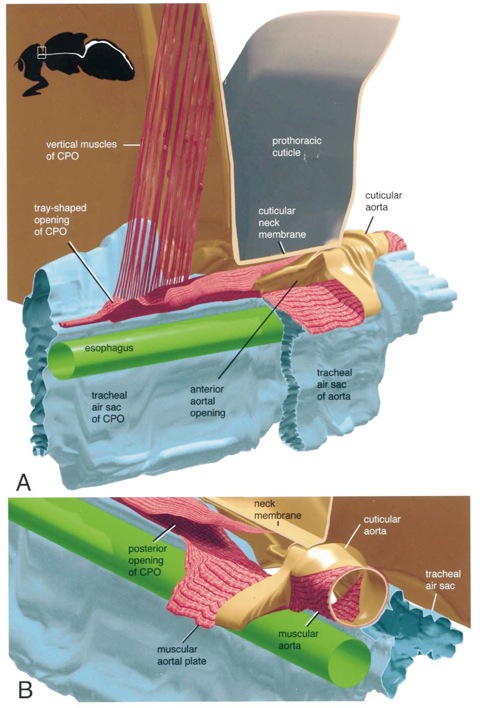in the blowfly Calliphora vicina (Diptera: Calliphoridae) and their roles in hemolymph transport
and tracheal ventilation, Int. J. Insect Morphol. Embryol. 28 (1-2) pp. 111-129.
In the blowfly Calliphora vicina (Diptera, Calliphoridae), the morphology of the dorsal vessel and of a new cephalic accessory pulsatile organ (CPO) were analysed with light-microscopic, SEM and TEM techniques. The CPO and neck aorta are reconstructed 2-dimensionally by computer-aided design. The pulse activity of the CPO and of the heart was measured in intact flies over periods of several hours or days using contact-thermography with laser beam heat-marking. The intratracheal pressure was simultaneously measured at the anterior thoracic spiracle. The dorsal vessel is constructed of pairs of left right alternating cells. Its enlarged chamber in the anterior abdomen contains two pairs of incurrent ostia, its posterior narrower heart tube possesses three pairs of incurrent ostia and paired caudal excurrent openings. The aorta opens with a funnel-like opening in the neck. Proportions, arrangement and ultrastructure of the aorta, heart cells and pericardial muscles are described. Cushionlike sarcoplasmic protrusions of heart cells (pair no. 17) probably function as internal valves. The neck aorta is constructed of a cuticular 'roof' deviating from the dorsal neck membrane and a ventral longitudinal muscle 'floor'. The aorta is not kept open because of missing muscle or connective tissue strands. The underside of the CPO is fused with air sacs that function as antagonists to the muscles. The heart reverses its beat periodically in resting and active flies. During the longer forward-pulse periods, mean frequency is lower (about 3.0 Hz at Ta 20°C), during the shorter backward periods mean frequency is higher (4.6 Hz). The CPO beats only during forward-pulse periods of the heart with an independent and slower pulse rate (1.8 Hz). The CPO produce positive pressure pulses at the anterior thoracic spiracle. During backward-pulse periods of the heart and pulse pause of the CPO, a continuous negative pressure arises at the thoracic spiracle instead of pressure pulses. The intimate connection of an accessory pulsatile organ with tracheal air sacs makes it work as a bifunctional pump for hemolymph distribution and tracheal ventilation. Neurosecretory and synapsing innervation of the CPO in connection with aorta, heart and pericardial septum muscle innervation suggest that both organs are regulated and that the duration of their periods is neuronally coordinated.

3D-reconstruction of the cephalic pulsatile organ (CPO) in Calliphora. (A) Lateral view of the complete organ showing the anterior opening of the aorta and the opening of the tray-shaped CPO. (B) View on the cut aorta showing the sandwich of outer cuticula and inner muscle layer.

